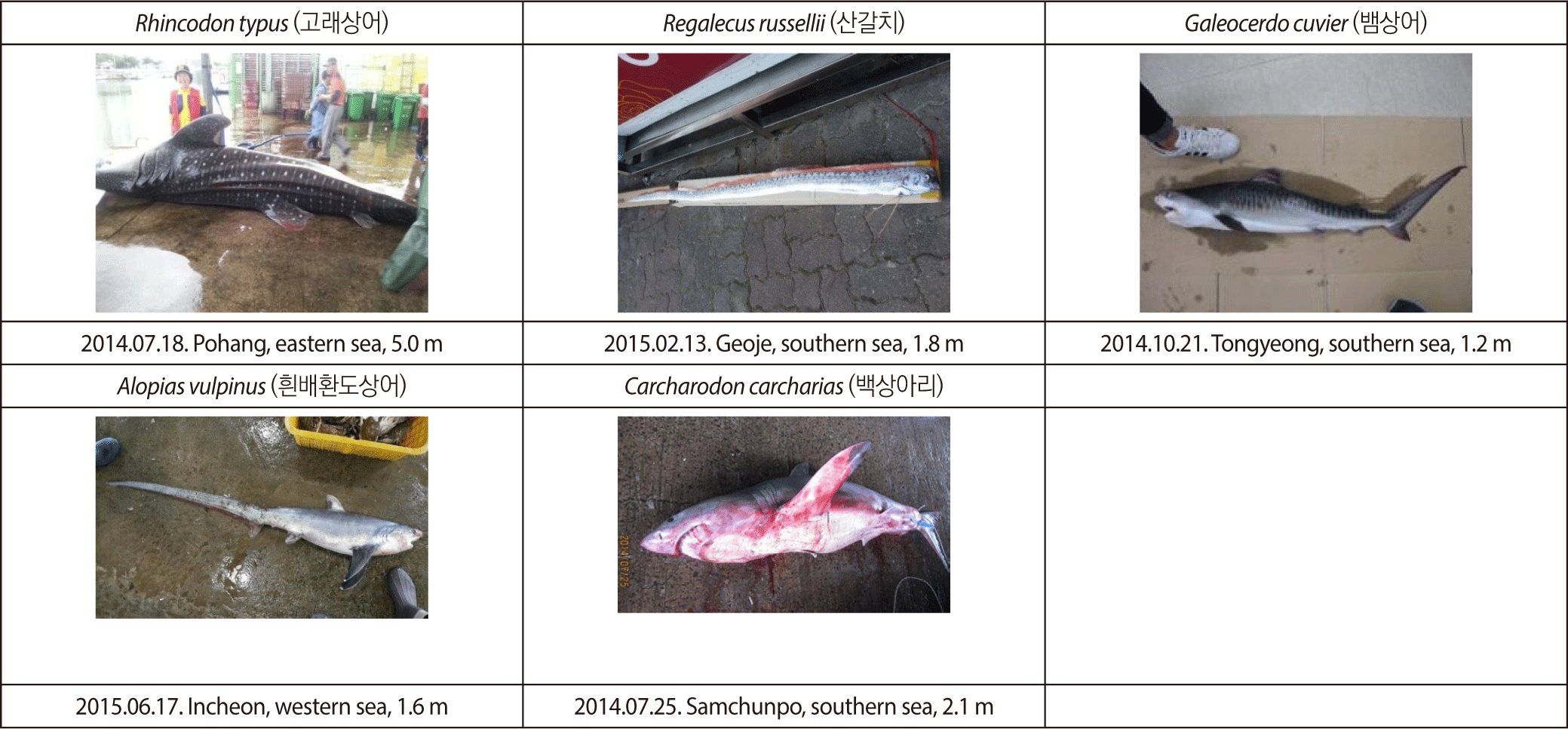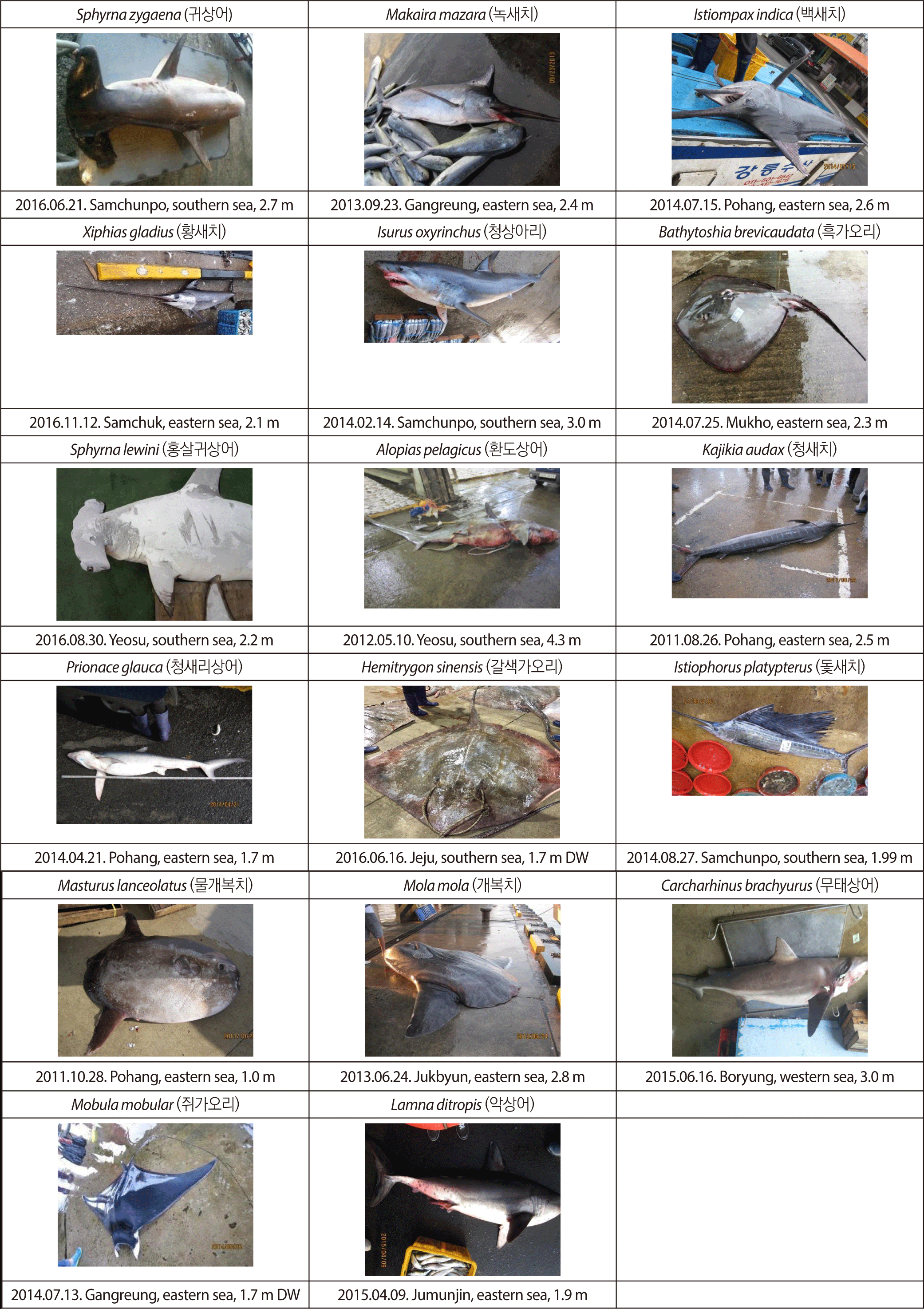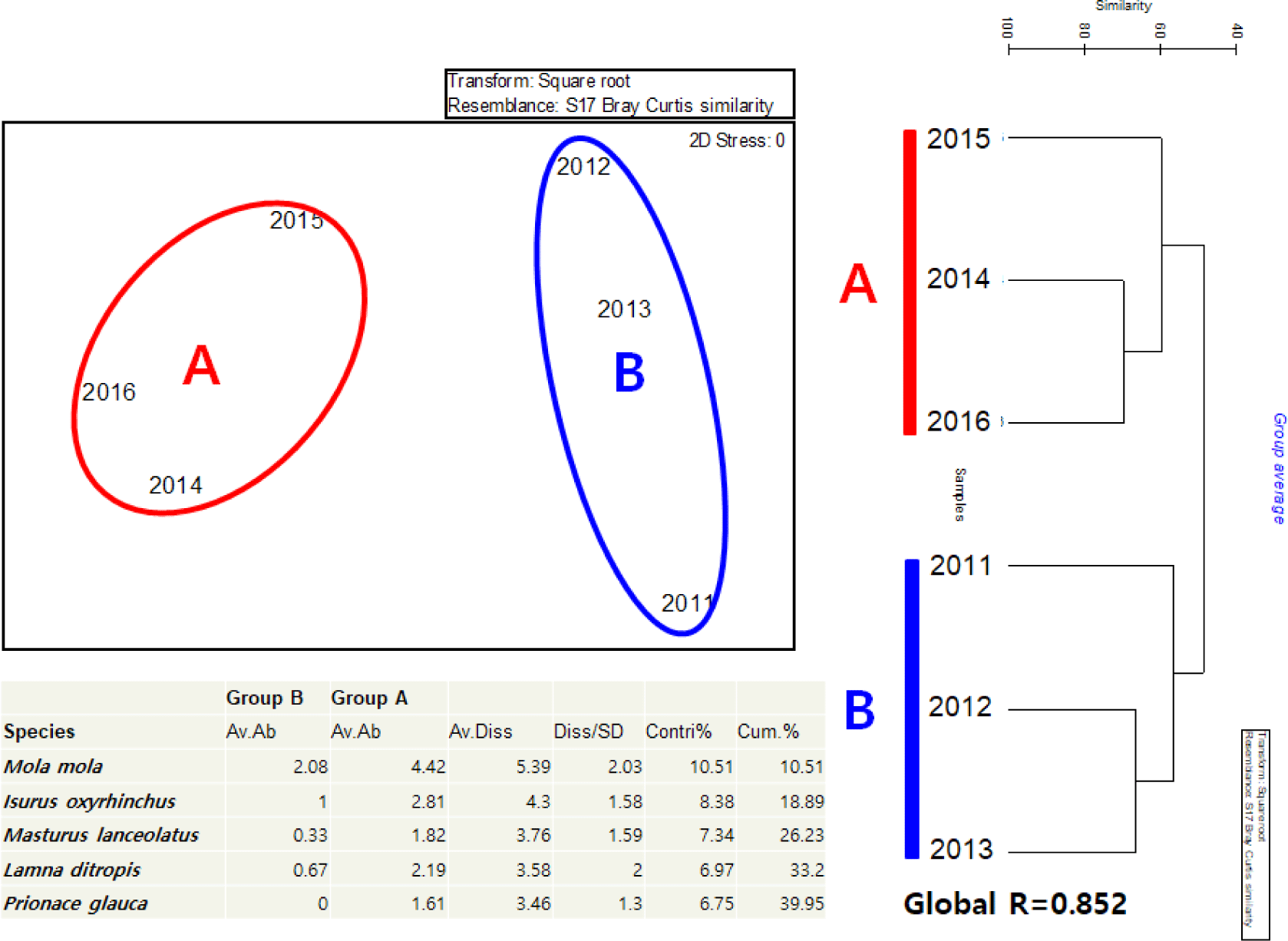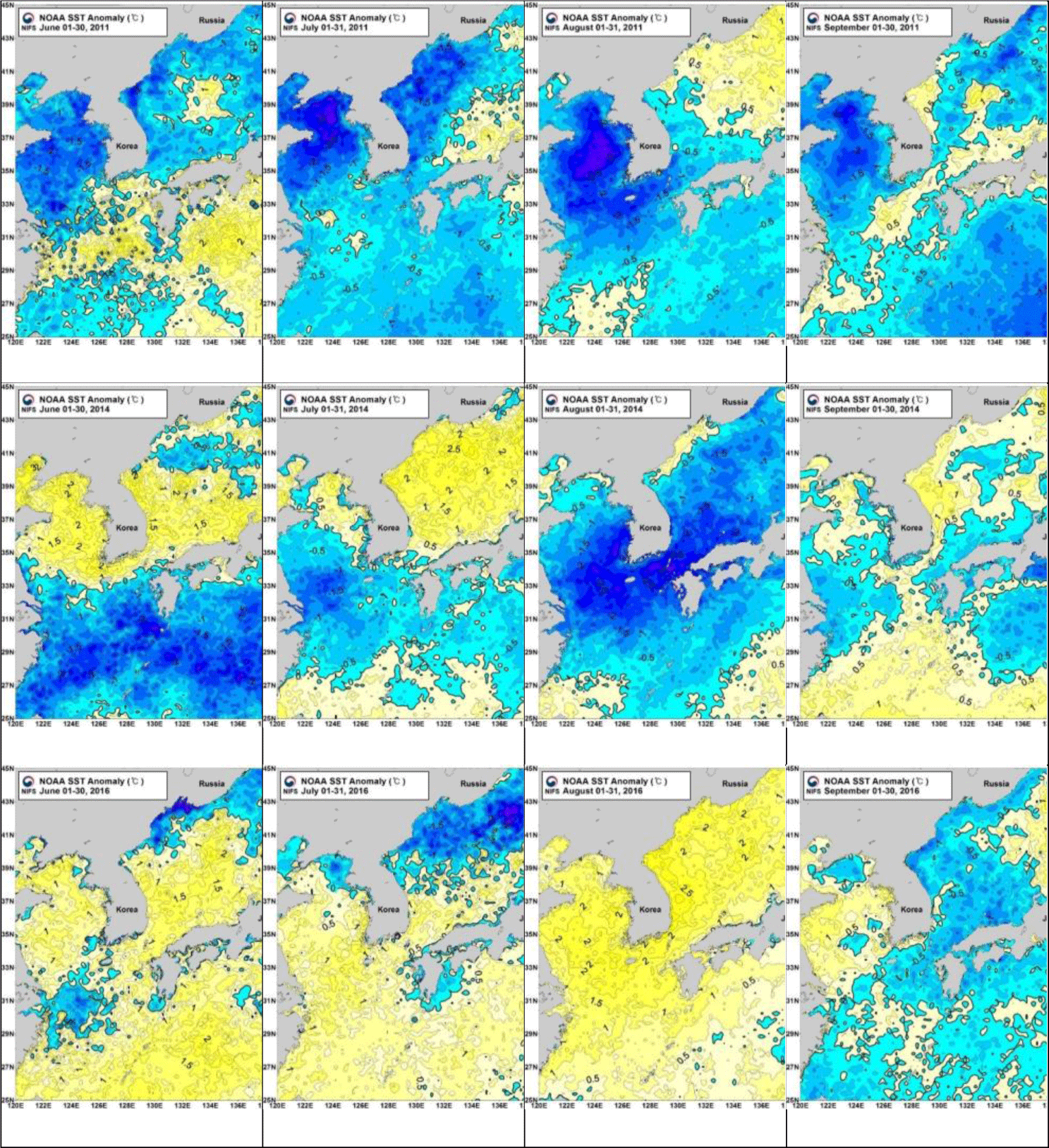Introduction
A variety of ongoing studies are attempting to define the effects of climatic change and the subsequent responses of marine ecosystems. In recent years, these have included research into the effects of rising sea temperature on fish communities in the North Sea (Hofstede & Rijnsdorp, 2011), the effects of climatic change on the California Current ecosystem (King et al., 2011), the decline in walleye pollack recruitment in the east Bering Sea (Mueter et al., 2011), and sea level rises with global warming (Domingues et al., 2008; Oh et al., 2011). A study of the relationship between sea surface temperature (SST) and fish community structure in the North Sea in the past 140 years showed that SST had remained in the range of 6°C–6.5°C between 1870 and the late 1980s, when it increased rapidly, reaching a peak of about 8°C in 2000, causing changes in the fish community structure (Hofstede & Rijnsdorp, 2011). Together with climatic change, SST has increased rapidly around the Korean peninsula in the last four decades, with the SST of Jeju island increasing by about 0.8°C and that of the Korea Strait by about 1.0°C (Jung et al., 2013). Increasing SST causes fluctuations in the biomass at the lower trophic levels, including among diatoms (Tian et al., 2008), the fish species alternation phenomenon (Rebstock & Kang, 2003), and impacts on marine ecosystem and fisheries resources (Zhang et al., 2000). A regime shift occurred in the late 1980s or early 1990s, causing changes in diverse biota around the Korean peninsula (Rebstock & Kang, 2003). Despite many studies on the relationship between marine ecosystem change and climatic regime shift, there have been no reports examining the long-term occurrence of giant and large fish species associated with climatic-driven oceanic changes in Korea until now.
Occupying the position of top predators in the marine ecosystem, giant and large fish species (except plankton feeders such as whale shark) are of great importance as keystone species that regulate the marine ecosystem (Camhi et al., 1998; Compagno, 1990). Recently, increasing attention has also been paid to ecosystem-based fisheries management (Heath et al., 2003), which has intensified the interest in giant and large fish species as top predators in the marine ecosystem, but very little data are available on those species. This lack of data is due to the rarity of these species in catches and the extreme difficulty of transporting them to labs for analysis (Lee et al., 2013). Research carried out by Korean scientists on giant and large fish species is available as simple reports of the occurrences of Carcharodon carcharias (Choi, 2009; Choi & Nakaya, 2002), Mola mola (Lee et al., 2013), Regalecus russelii (Lee et al., 2013), Somniosus pacificus (Kang et al., 2015), and Lampris guttatus (Jeong et al., 2015), on the feeding of six shark species (Huh et al., 2010) and on the maturation and spawning of M. mola (Kang et al., 2015). Most giant and large fish species are susceptible to overexploitation due to their long life spans and late maturity. Once such species are overexploited, recovery of their stocks is difficult. Chondrichthyes species including sharks, skates, and rays are under high fishing pressure and have late maturity and low fecundity and are therefore under particular risk of stock depletion (Camhi et al., 1998; Compagno, 1984; Norman, 2005). According to the IUCN (2021), most of these species are listed as critically endangered (CR), endangered (EN), vulnerable (VU) or near threatened (NT), indicating how vulnerable these giant and large fish species are to fishing and overfishing. Therefore, even with small catch numbers, a different approach is needed to assess the stocks of these giant and large fish species from that used for small or medium fish to develop proper measures for their conservation. This study was carried out to provide an overview of the recent occurrences of giant and large fish species in Korean waters, and the results of this study are intended to contribute to the establishment of conservation measures.
Materials and Methods
A list of giant and large fish species occurring in Korean waters was compiled based on daily reports over 6 years from 2011 to 2016 collected by observers from the Korea Fisheries Resources Agency dispatched at 57 landing sites along the Korean coastline operated by Fisheries Cooperative (9 landing sites in Gangwon province, 7 in Gyeongbuk province, 4 in Ulleungdo island, 11 in Gyeongnam province, 3 in Busan city, 6 in Jeju island, 8 in Jeonnam province, 2 in Jeonbuk province, 4 in Chungnam province, and 3 in Incheon city). The daily reports included images and the morphological characteristics on which species identification was based. These data were carefully examined to confirm species identification with the aid of Nakaya (2011) and Nakabo (2013). Reports with low-resolution images and uncertain species identification were excluded from our study. Classification including scientific name follows the Kim et al. (2020) and Froese & Pauly (2021).
We artificially classified fish into small, medium, large, and giant categories, which were respectively defined as those with a maximum total length (MTL) of less than 1.0, 1.01–3.0, 3.01–5.0, and over 5.01 m. We applied this classification to create a list of giant and large fish species and also included fish species with MTLs of 3.01 m or larger described by Froese & Pauly (2021). We also reorganized and analyzed the size data for giant and large fish recorded by observers at the landing sites, which were included in the list.
In order to analyze the temporal and spatial distributions of SST in around the Korean peninsula, we utilized daily band images from NOAA satellite which were directly received by the National Institute of Fisheries Science (NIFS) of Korea. SST images were obtained from monthly means of daily Multi-Channel Sea Surface Temperature (MCSST) based on NOAA advanced very high resolution radiometer (AVHRR) band and which were determined average variations of the oceanic conditions in areas bounded between 25–45°N in latitude and 118–142°E in longitude during 2011–2016 (NIFS, 2015).
Cluster analysis was performed based on the number of individuals per species after square root transformation during the study period by year and sea (eastern sea, southern sea, and western sea) and analysis of similarities was carried out to determine the statistical significance of the cluster. A analysis of similarity percentages was performed to determine the species contributing to the division. All of these analyses were performed using Primer version 6.0.
Results and Discussion
Among the fish recorded by observers in the Korea Fisheries Resources Agency from 2011 to 2016 at 57 landing sites around the Korean waters, the fish species with a MTL of 3.01 m or more are listed in Table 1. Regardless of the actual size of all fish individuals at landing sites, all fish were included in the category of giant or large fish according to the MTL of each fish species described by Froese & Pauly (2021). As a result, a total of five species of giant fish and 17 species of large fish were confirmed to occur in Korean waters during the survey period.
Data from Froese & Pauly (2021).
Although actual recorded size of five species is less than 5 m, they belong to the giant fish category according to Froese & Pauly (2021). The five giant fish species and actual recorded size are as follows: Rhincodon typus (3.9–5.3 m TL), R. russelii (1.8–3.3 m TL), Galeocerdo cuvier (1.2 m TL), Alopias vulpinus (1.1–5.0 m TL), and C. carcharias (1.5–4.5 m TL) (Fig. 1 and Table 1). Aside from R. russelii, the other four species belong to Chondrichthyes. During the survey period, A. vulpinus showed the highest frequency of occurrence with 13 accidentally caught individuals, followed by C. carcharias with 9 individuals, R. typus with 8 individuals, R. russelii with 2 individuals and G. cuvier with 1 individual.

The whale shark (R. typus), the only species in the family Rhincodontidae, is the largest fish species on earth, growing as long as 17 m. It has a world-wide distribution (GBIF, 2021), and is a docile shark that filter feeds on small fish, crustaceans and squid (Compagno, 1984; Nakabo et al., 2001; Norman, 2005; Taylor, 2007). In Korea, records of this species can only be found in fish picture books or media reports (Chyung, 1977; Kim et al., 2005), but there is no specimen-based record on occurrences. Our survey found a total of eight whale shark individuals over a period of 6 years, particularly during the summer season (July–September) (Table 2). Their total lengths ranged from 3.9 to 5.3 m (average 4.61 m), and all were below 8 m, the length at which 50% of male individuals are mature (30 years old) (Norman & Stevens, 2007). Accidental catches of three individuals each occurred in Gangwon and Gyeongbuk provinces by set net, indicating that the whale shark occurs mainly in the eastern sea of Korea (Table 3). The whale shark is ovoviviparous, with over 300 embryos in various developmental phases found in the uterus of a fish that was 10.6 m in total length (Joung et al., 1996). R. typus is listed as VU on the IUCN Red List (IUCN, 2021), and international trade of this species is restricted under CITES (CITES, 2021). Even though the number of by-catch was low in Korea, it is essential to design the avoidance protocols in the set net fishermen in the eastern sea of Korea.
The largest species among Osteichthyes, the oarfish (R. russelii) is distributed in the Pacific Ocean, and grows as long as 8 m and can self-amputate the posterior part of its body (Froese & Pauly, 2021; Nelson & Grande, 2016). A total of two R. russellii individuals were accidentally caught during the survey period: one in Jumunjin (eastern sea of Korea) in November and one in Geoje (southern sea of Korea) in February (Tables 2 and 3). Lee et al. (2013) reported that the stomachs of two oarfish collected from the eastern sea of Korea were full of euphausiids, which is consistent with the results of previous research on its prey (euphausiids, small fish, and cephalopods; Palmer et al., 1986; Roberts, 2012). Their occurrence may be associated with prey. These accidentally caught individuals had total lengths of 1.8–3.3 m (average 2.55 m), all below the species’ known MTL of 8.0 m (Compagno, 1984). R. russellii is listed as least concern (LC) on the IUCN Red List (IUCN, 2021).
The tiger shark (G. cuvier), in the family Carcharhinidae grows as long as 7.5 m (Vidthayanon, 2005) and is the third largest species among those surveyed in our study, following R. typus and R. russelii. With no voucher specimens in Korea (Choi, 2009), and only one accidentally caught individual found in this survey, the tiger shark is considered a very rare species in Korean waters. According to Myers (1991), a female tiger shark can give birth to as many as 80 pups with total lengths ranging from 0.51 to 1.04 m, and thus the 1.2 m long tiger shark reported in this survey may be considered a newborn pup. We identified the tiger shark based on its dark dorsolateral stripes, which distinguish this species from other shark species (Choi, 2016; Nakabo, 2013). The tiger shark is distributed around the world (GBIF, 2021), found at the surface or at shallow depths of less than 140 m (Smith, 1997), and occasionally swims into river estuaries (Compagno, 1984). G. cuvier is listed as NT on the IUCN Red List (IUCN, 2021).
The common thresher (A. vulpinus) accounted for a total of 13 accidental catches during the survey period, most of which occurred from May to July over a wide area (Table 2); five individuals each were caught in Gyeongbuk (eastern sea of Korea) and Jeonnam (western sea of Korea) (Table 3). The surveyed common threshers had total lengths of 1.1–5.0 m (average 2.65 m), thus approximately half of the species’ MTL of 5.7 m (Compagno, 1984). The common thresher belongs to the family Alopiidae and feeds on fish, squid and crustaceans by stunning them with powerful swipes of its caudal fin, which is as long as the rest of its body (Compagno, 1984). Being ovoviviparous, the developing embryos feed on other eggs ovulated by the mother (Compagno, 2001). The common thresher resembles the congeneric species A. pelagicus but can be distinguished from the latter by the white of its belly extending in a band over the bases of its pectoral fins (Nakabo, 2013). The common thresher has a world-wide distribution (GBIF, 2021), and occurs in all seas of Korean waters (Choi, 2016), which is consistent with the results of our survey (Table 3). The species is currently listed as VU on the IUCN Red List (IUCN, 2021).
During the survey period, there were nine accidental catches of the great white shark (C. carcharias), which occurred mostly in June–September and November–January (Table 2). Based on this result, the great white shark seems to migrate to Korean waters after June. Landing areas include Gyeongbuk (eastern sea of Korea) and Chungnam provinces (western sea of Korea) (Table 3). The accidentally caught great white sharks had total lengths ranging from 1.5 to 4.5 m (average 2.28 m). Most were less than half of the species’ MTL of 7.0 m (Nakaya, 2011). There are a total of six reported fatal human attacks by the species in Korean waters, all occurring during the month of May in Jeonbuk and Chungnam provinces (western sea of Korea; Choi & Nakaya, 2002). These changes are assumed to have contributed to the recent shift in the migratory route of the great white shark from the western sea of Korea (11 individuals in the west and 6 in the east; Choi, 2016) to the eastern sea of Korea (3 individuals in the west and 5 in the east; the present study). Great white shark attacks on divers collecting shellfish have been reported in the western sea of Korea; the divers were likely recognized as prey or food competitors by the species (Choi, 2016). According to the size data of great white sharks observed in Korean waters, no individuals were 1 m or less, 7 individuals were 1.01–3.0 m, 11 individuals were 3.01–5.0 m, and 1 individual was 5.01 m or longer (Choi, 2009; Choi & Nakaya, 2002). Thus, this species can be categorized as giant fish with a high risk of human attack. C. carcharias has a world-wide distribution (GBIF, 2021), is listed as VU and moderately depleted (MD) on the IUCN Red List (IUCN, 2021), and international trade of this species is restricted under CITES (CITES, 2021).
Our survey found 17 fish species were classified as large fish category with a MTL of 3.01–5.0 m according to Froese & Pauly (2021) (Fig. 2 and Table 1). Taxonomically, 10 and 7 of these species belong to Chondrichthyes and Osteichthyes, respectively. Among the cartilaginous fish species, 7 were sharks and the other 3 rays. Among the seven bony fish species, five and two are billfish and ocean sunfish, respectively. During the survey period, M. mola was the dominant species, followed by I. oxyrinchus, M. mobular, L. ditropis, S. zygaena, and P. glauca comprising 75, 31, 23, 17, 14, and 12 individuals, respectively (Table 1).

Sharks have been seriously overexploited due to increasing demand for shark fin (Choi, 2016). Most shark species tended to occur all around the year in the eastern sea of Korea (Tables 2 and 3). Among large sharks reported by the observers, S. lewini was classified as EN, I. oxyrinchus, Alopias pelagicus, and S. zygaena as VU, P. glauca and Carcharhinus brachyurus as NT and L. ditropis as LC (IUCN, 2021). In particular, international trade of S. zygaena is prohibited under CITES (CITES, 2021). Sound studies on various conservation measures for shark species under increasing demand are necessary for their conservation and management by IUCN and CITES. The survey showed that sharks were caught most frequently using a set net (40.5%), followed by gill net (24.3%), stow net (10.8%), coastal complex fishery (8.1%), bottom trawl (8.1%), angling (5.4%), and purse seine (2.7%). Considering the high accidental catch rate using set nets, application of shark-deterrent devices or escape devices to set nets is essential.
During the survey, a total of five billfish species (Istiophorus platypterus, Istiompax indica, Makaira mazara, Kajikia audax, and Xiphias gladius) were identified, representing the second greatest variety of large fish species. Among the five species, four belong to the family Istiophoridae and one to the Xiphiidae. A total of 30 billfish individuals were accidentally caught during the survey period. Their measured total lengths ranged from 1.0 to 3.3 m, with most individuals longer than 2.0 m. Excluding X. gladius (which occurred during February, July, August, and November), most billfish species occurred during summer (July–September) (Table 2) in the eastern sea of Korea (Table 3). IUCN classifies K. audax as NT, I. platypterus and X. gladius as LC (IUCN, 2021).
The survey revealed that the ocean sunfish (M. mola) and sharptail mola (Masturus lanceolatus) were caught primarily in the eastern sea of Korea, while the ocean sunfish was occasionally caught around Jeju island and in the western sea of Korea (Table 3). During the 6-year survey period, a total of 75 occurrences of M. mola and 16 occurrences of M. lanceolatus were observed. The ocean sunfish was caught year-round, with most occurrences concentrated in June–August (71% of the total) (Table 2). The sharptail mola was found in July and August–November, which is shorter than the catch period of the ocean sunfish (Table 2). According to Lee et al. (2013), a total of 496 ocean sunfish (M. mola) were caught in the waters of Jeju island over 3 years from 2010 to 2012, which indicates a significant difference from our results. Such a difference in the main fishing ground of ocean sunfish (Gyeongbuk in the present study vs. Jeju island in Lee et al., 2013) should be closely reexamined in a future study. Furthermore, Lee et al. (2013) assumed that M. mola is mainly distributed around Jeju island and in the eastern sea of Korea and suggested that further detailed studies are needed to understand the extent of habitat, distribution, and ecological migratory route of the species. Later, Kang et al. (2015) carried out microscopic examination of the gonad of the ocean sunfish and suggested a potential spawning near Jeju island between July and October. IUCN categorizes M. mola as VU and M. lanceolatus as LC (IUCN, 2021).
There are 633 ray species in 26 families distributed across the world, among which 10 species are listed as CR, 30 as EN, 72 as VU, 58 as NT, 144 as LC, and 243 as data deficient (DD) on the IUCN red list (Last et al., 2016). Among the ray species surveyed, the three species Bathytoshia brevicaudata, Hemitrygon sinensis, and M. mobular were classified as large fish species. M. mobular was the most dominant species, comprising 23 individuals, followed by B. brevicaudata (9 individuals) and H. sinensis (8 individuals). In terms of season, M. mobular mostly occurred during June–August and H. sinensis during September, whereas B. brevicaudata occurred almost year-round (Table 2). In terms of occurrence area, B. brevicaudata occurred widely including three seas, but H. sinensis and M. mobular occurred mainly at the eastern sea of Korea (Table 3). IUCN categorizes M. mobular as NT (IUCN, 2021), and CITES also limitedly prohibited international trade of the species (CITES, 2021).
Cluster analysis produced of giant and large fish species by year resulted in two clusters divided at the Bray-Curtis similarity of 50. One cluster includes years after 2014 and the other includes years before 2013, with 2011 being the most distinct, and 2014 and 2016 the most similar years. The species that drove the differentiation between periods were M. mola (contribution = 10.51%), I. oxyrinchus (8.38%), M. lanceolatus (7.34%), L. ditropis (6.97%), and P. glauca (6.75%) (Fig. 3). M. mola accounted for the largest number of individuals, 64% of the total in 2014 and 2016, and 71% in summer (June–August). In addition, as a result of cluster analysis based on species composition of giant and large fish species by sea, the eastern sea of Korea was closely clustered with the southern sea of Korea, and the western sea of Korea was more distant. The most important differentiating species were M. lanceolatus (contribution = 9.21%), L. ditropis (9.08%), I. oxyrinchus (6.77%), R. typus (6.51%), and X. gladius (6.18%).

We analyzed the SST of summer (June–September) when frequency of occurrence of M. mola and I. oxyrinchus was the highest. M. mola were most frequently caught in August 2014 and July 2016, when the SST anomaly was particularly negative (–). I. oxyrinchus also showed the highest frequency of occurrence in July 2014, July 2015, and September 2016, and even at this time, the SST anomaly was negative (Fig. 4). This indicates that the SST of when a large number of M. mola and I. oxyrinchus occurred is lower than the average SST for the past 30 years. Therefore, it is not necessarily considered that giant and large fish species increase only by rising SST, suggesting that there may exist a species-specific suitable seawater temperature range or any other reason such as prey abundance.

Notwithstanding, increases in seawater temperature have recently been associated increased frequency of occurrence of many subtropical species in Jeju island and the eastern sea of Korea (Kim, 2009; Kim et al., 1999; Lee & Kim, 2021; Lee et al., 2021) and change in fish community structure (Jung et al., 2013; Ryu & Kim, 2020). Rebstock & Kang (2003) provided evidence for variations in regime shifts in the three seas around the Korean peninsula, for example, the abundance of amphipods, chaetognaths, and euphausiids increased in the eastern and southern seas of Korea, but not the western sea of Korea. Indeed, the ecosystem of the western sea of Korea differs from that of the eastern and southern seas of Korea, which was supported by physical (Kim, 2009; Lie, 1989; Seung, 1992) and biogeographic data (Bae et al., 2020; Gwak & Nakayama, 2011; Kim et al., 2017; Myoung & Kim, 2014). Most recently, Ryu & Kim (2020) carefully suggested that the thermal front of the middle East Sea moved north from Jukbyun to Jumunjin by comparing the past and present fish fauna. In order to better understand the yearly fluctuations of giant and large fish species in Korean waters, it requires further study linking marine environmental variables (e.g., temperature or salinity), with biological characteristics (e.g., prey or habitat preference).
